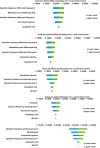A cost-minimization analysis of anti-VEGFs for the treatment of neovascular age-related macular degeneration in the Netherlands
- PMID: 39322853
- PMCID: PMC11868297
- DOI: 10.1007/s00417-024-06588-6
A cost-minimization analysis of anti-VEGFs for the treatment of neovascular age-related macular degeneration in the Netherlands
Abstract
Objective: Age-related macular degeneration (AMD) is the main cause of severe vision loss globally. Neovascular AMD (nAMD) is an advanced stage of AMD treated with anti-vascular endothelial growth factors (anti-VEGFs). Although anti-VEGF treatment is effective, the frequent intravitreal injections place a burden on patients, (in)formal caregivers, and clinics. This study assesses the health-economic impact of anti-VEGF agents with lower injection frequency that have the potential to reduce treatment burden and compares it to the standard of care.
Methods: We developed a cost-minimization model to evaluate the direct medical costs associated with first-line unilateral anti-VEGF treatment across a 3-year time horizon in the Netherlands. The analysis compared aflibercept 8 mg, aflibercept 2 mg, bevacizumab, faricimab, and ranibizumab. Our model adopted a treat-and-extend (T&E) regimen for aflibercept 2 mg, bevacizumab, and ranibizumab. For aflibercept 8 mg, a flexible regimen that was extendable up to 24 weeks was applied, while faricimab followed a flexible regimen that was extendable up to 16 weeks. Additionally, since list prices may vary from net prices, we calculated the break-even price for each anti-VEGF in comparison to bevacizumab, which is the recommended first-line treatment due to its low medication price.
Results: Based on list prices, aflibercept 8 mg led to the lowest treatment costs (€16,251 per patient over a 3-year time horizon), closely followed by bevacizumab (€17,616 per patient over a 3-year time horizon). Ranibizumab led to the highest per-patient costs (€31,746 over a 3-year time horizon). For bevacizumab, most costs were attributable to administration, while for the other anti-VEGFs, most were attributable to medication. Aflibercept 8 mg is cost-saving compared to bevacizumab at their medication prices at the time of writing. Aflibercept 2 mg, faricimab, and ranibizumab should be priced below €488, €591, and €75, respectively. To be cost-equal to bevacizumab with current list prices, anti-VEGFs should be administered with a maximum of 12.7 to 13.8 injections over a 3-year time horizon.
Conclusion: According to the injection frequency observed in clinical trials, aflibercept 8 mg would be the anti-VEGF that generates the lowest per-patient healthcare costs for the treatment of nAMD in the Netherlands after a treatment period of three years. Our study indicates that anti-VEGF drugs with a lower injection frequency might provide a cost-saving solution to the increasing burden of anti-VEGF treatment on the healthcare system.
Keywords: Anti-VEGFs; Cost-minimisation; Neovascular age-related macular degeneration.
© 2024. The Author(s).
Conflict of interest statement
Declarations. Ethical approval: This article does not contain any studies with human participants or animals performed by any of the authors. Conflict of interest: SwQ and HN are employees of Asc Academics, which received funding of Bayer BV, Pharmaceuticals Divison. MJP received grants and honoraria from various pharmaceutical companies, all unrelated to this work and reports stocks of and advisorships for PAG BV, Health-Ecore and ASC Academics (all in Groningen, The Netherlands). SA performed consultancy work for Novartis, Bayer, horus pharma, and Roche. FvA has no conflicts of interest to declare.
Figures



Similar articles
-
Anti-VEGFs for Diabetic Macular Oedema: Analysis of Efficacy, Safety, and Cost of More Durable Therapies from a Dutch Societal Perspective.Adv Ther. 2025 Aug;42(8):3774-3794. doi: 10.1007/s12325-025-03233-4. Epub 2025 Jun 7. Adv Ther. 2025. PMID: 40481910 Free PMC article.
-
Cost-minimisation analysis of a treat-and-extend regimen with anti-VEGFs in patients with neovascular age-related macular degeneration.Graefes Arch Clin Exp Ophthalmol. 2022 Apr;260(4):1083-1095. doi: 10.1007/s00417-021-05359-x. Epub 2021 Oct 13. Graefes Arch Clin Exp Ophthalmol. 2022. PMID: 34643793 Free PMC article.
-
Cost-minimisation analysis of anti-VEGF therapies in neovascular age-related macular degeneration and diabetic macular oedema in Switzerland.J Med Econ. 2025 Dec;28(1):1198-1213. doi: 10.1080/13696998.2025.2536420. Epub 2025 Jul 29. J Med Econ. 2025. PMID: 40692491
-
Treatment regimens for administration of anti-vascular endothelial growth factor agents for neovascular age-related macular degeneration.Cochrane Database Syst Rev. 2020 May 5;5(5):CD012208. doi: 10.1002/14651858.CD012208.pub2. Cochrane Database Syst Rev. 2020. PMID: 32374423 Free PMC article.
-
The cost-effectiveness of bevacizumab, ranibizumab and aflibercept for the treatment of age-related macular degeneration-A cost-effectiveness analysis from a societal perspective.PLoS One. 2018 May 17;13(5):e0197670. doi: 10.1371/journal.pone.0197670. eCollection 2018. PLoS One. 2018. PMID: 29772018 Free PMC article.
References
-
- Volksgezondheidsinfo (2021) Gezichtsstoornissen | Leeftijd en geslacht | Maculadegeneratie. https://www.vzinfo.nl/gezichtsstoornissen-leeftijd-en-geslacht-maculadeg.... Accessed 27 Jul 2023
-
- Mehta S (2015) Age-related macular degeneration. Prim Care - Clin Office Pract 42:377–391. 10.1016/j.pop.2015.05.009 - PubMed
MeSH terms
Substances
LinkOut - more resources
Full Text Sources

